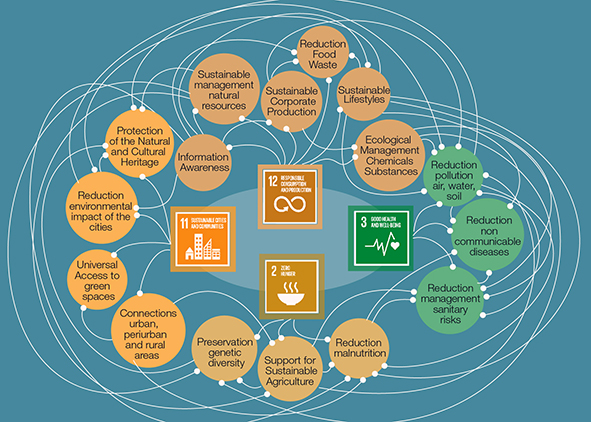The planning of a territorial network among food, health and design
DOI:
https://doi.org/10.19229/2464-9309/8252020Keywords:
multidisciplinarity, systemic design, sustainable agri-food systems, territorial well-being, conscious communityAbstract
Today’s high-impact food production and consumption patterns are contributing to the loss of biodiversity and cultural identity, triggering irreversible change. This is why healthy nutrition, as the foundation of a socio-environmental balance, is considered transversally in the challenges suggested by the 2030 Sustainable Development Goals. The aim of this article is to investigate how the pursuit of better health at community level can be achieved through a multidisciplinary territorial project. The article describes the Cibo, Comunità e Salute project – developed by the Department of Architecture and Design of Politecnico di Torino and the CioCheVale Association – which has initiated a useful discussion between different stakeholders on the themes of food, health and sustainability, mediated and guided by systemic design.
Downloads
Article Metrics Graph
References
Berrino, F. (2015), Il Cibo dell’uomo – La via della salute tra conoscenza scientifica e antiche saggezze, FrancoAngeli, Milano.
Bistagnino, L. (2011), Systemic Design – Designing the productive and environmental sustainability, Slow Food Editore, Bra.
Capra, F. and Luisi, P. L. (2014), Vita e natura – Una visione sistemica, Aboca.
Catania, A. (2017), “Design e Ficodindia per uno Sviluppo locale sostenibile | Design and Prickly Pear for a Sustainable Local Development”, in Agathón | International Journal of Architecture, Art and Design, vol. 2, pp. 227-234. [Online] Available at: doi.org/10.19229/2464-9309/2302017 [Accessed 07 October 2020].
Fagnoni, R. (2018), “Da ex a next – Design e territorio – Una relazione circolare basata sulle tracce”, in MD Journal, vol. 5, pp. 16-27. [Online] Available at: mdj.materialdesign.it/index.php/mdj/article/view/113/109 [Accessed 04 November 2020].
Fassio, F. and Tecco, N. (2018), Circular Economy for Food – Materia, energia e conoscenza, in circolo, Edizioni Ambiente, Milano.
GBD 2017 Diet Collaborators (2019), “Health effects of dietary risks in 195 countries, 1990-2017 – A systemic analysis for the Global Burden of Disease Study 2017”, in The Lancet, vol. 393, issue 10184, pp. 1958-1972. [Online] Available at: doi.org/10.1016/S0140-6736(19)30041-8 [Accessed 07 October 2020].
Granovetter, M. S. (1973), “The Strenght of Wick Ties”, in American Journal of Sociology, vol. 78, issue 6, pp. 1360-1380. [Online] Available at: www.jstor.org/stable/2776392 [Accessed 4 November 2020].
Hsu, C. and Lapalme, H. (2019), “Hospitals as Anchor Institutions – Ecosystemic Leadership to Nourish Patient, Community, and Planetary”, in Jones, P. (ed.), Proceedings of Relating Systems Thinking and Design (RSD8) 2019 Symposium, IIT Institute of Design, Chicago, October 13-15, 2019, pp. 1-5. [Online] Available at: systemic-design.net/rsd-symposia/rsd8-2019/health-and-well-being/ [Accessed 30 September 2020].
Irwin, T. (2015), “Transition Design – A Proposal for a New Area of Design Practice, Study, and Research”, in Design and Culture | The Journal of the Design Studies Forum, vol. 7, issue 2, pp. 229-246. [Online] Available at: dx.doi.org/10.1080/17547075.2015.1051829 [Accessed 15 September 2020].
Maffei, S., Villari, B., Tamini, L. and Parini, B. (2016), Social Food Club – Service e food design come abilitatori di nuovi modelli di sviluppo, innovazione e coesione sociale, Macro, Milano.
Manzini, E. and Meroni, A. (2014), “Catalyzing social resources for sustainable changes – Social innovation and community-centred design”, in Vezzoli, C., Kohtala, C. and Srinivasan, A. (eds), Product-Service System Design for Sustainability, Greenleaf Publishing, Sheffield, pp. 362-379.
Jones, P. H. (2013), Design for Care – Innovating Healthcare Experience, Rosenfeld Media, New York.
Parente, M. and Sedini, C. (2019), D4T – Design per i territori – Approcci, metodi, esperienze, List Editore, Trento.
Petrini, C. (2016), Buono, Pulito e Giusto – Principi di una nuova gastronomia, Slow Food Editore-Giunti, Bra.
Robin, M.-M. (2012), Il veleno nel piatto – I rischi mortali nascosti in quello che mangiamo, Feltrinelli, Milano.
Russo, D. and Tamborrini, P. (2018), D&T – Design e Territori, Palermo University Press, Palermo. [Online] Available at: www.unipapress.it/it/book/d&t--design-e-territori_123/ [Accessed 29 September 2020].
Shiva, V., Patwardhan, B. and Shiva, M. (2018), Cibo e salute – Manuale di resistenza alimentare, Terra Nuova Edizioni, Firenze.
Trasande, L. (2019), Sicker, Fatter, Poorer – The Urgent Threat of Hormone-Disrupting Chemicals to Our Health and Future … and What We Can Do about It, Houghton Mifflin Harcour, Boston.
Ulrich, R. S., Zimring, C., Zhu, X., DuBose, J., Seo, H.-B., Choi, Y.-S., Quan, X. and Joseph, A. (2008), “A Review of the Research Literature on Evidence-Based Healthcare Design”, in Health Environments Research & Design Journal, vol. 1, issue 3, pp. 61-125. [Online] Available at: doi.org/10.1177/193758670800100306 [Accessed 29 September 2020].
United Nations – General Assembly (2015), Transforming Our World – The 2030 Agenda for Sustainable Development, Resolution adopted by the General Assembly on 25 September 2015. [Online] Available at: www.un.org/ga/search/view_doc.asp?symbol=A/RES/70/1&Lang=E [Accessed 29 September 2020].
Wendel, S. (2013), Designing for Behavior Change – Applying Psychology and Behavioral Economics, O’Reilly, Sebastopol.

Downloads
Published
How to Cite
Issue
Section
License
This Journal is published under Creative Commons Attribution Licence 4.0 (CC-BY).
License scheme | Legal code
This License allows anyone to:
Share: copy and redistribute the material in any medium or format.
Adapt: remix, transform, and build upon the material for any purpose, even commercially.
Under the following terms
Attribution: Users must give appropriate credit, provide a link to the license, and indicate if changes were made; users may do so in any reasonable manner, but not in any way that suggests the licensor endorses them or their use.
No additional restrictions: Users may not apply legal terms or technological measures that legally restrict others from doing anything the license permits.
Notices
Users do not have to comply with the license for elements of the material in the public domain or where your use is permitted by an applicable exception or limitation.
No warranties are given. The license may not give users all of the permissions necessary for their intended use. For example, other rights such as publicity, privacy, or moral rights may limit how you use the material.


















































































